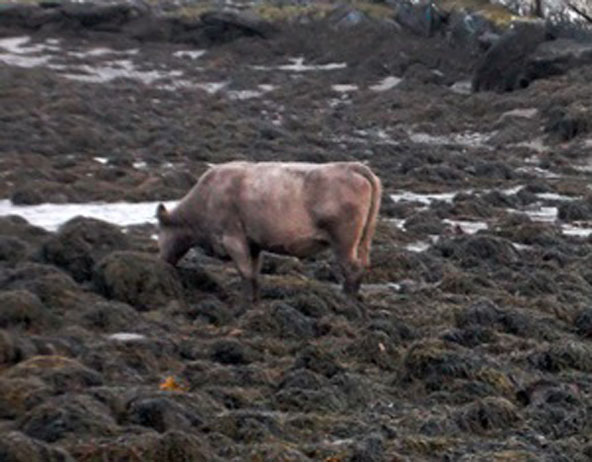
The Icelanders lay in a store of seaweed for a winter supply by washing the plants and then packing them in trenches where they are compressed with heavy oak planks and stones. The compressed mass is broken up as required and fed to the animals without the smell or taste of milk from cows being affected. Sometimes, Alaria, after washing, is air-dried and then stored in layers in barns, each layer alternating with a layer of hay. At least one seaweed meal factory has existed since 1960 and some weed is extracted to provide a liquid plant nutrient. In Iceland, geothermal heat provides a possible cheap means of drying the weed. In Finland, both Laminaria and Alaria are used as fodder for cattle.
In certain coastal areas of Norway, sheep are fed regularly on seaweed and after several generations it has been found that they digest it far better than inland animals. This accords with experimental evidence on the utilization of seaweed foods
In Scotland, sheep and cattle wander down on to the foreshore and eat various algae. In the small, most northerly island of the Orkneys, North Ronaldsay, there is a local race of small black sheep which feed entirely on seaweed. The whole island is surrounded by a wall which keeps the animals out on the shore. Several hundred (up to 2000) sheep browse on the seaweeds and are allowed to enter a pasture only when in lamb or just before slaughter. They suffer from very few diseases. Opinion differs as to whether the meat tastes fishy or not, but the wool is regarded as being of a superior quality. On the west coast of Scotland, around Loch Feochan, Pelvetia is fed to pigs when they are being fattened for market, the weed being given raw or boiled up and mixed with oatmeal, when it is also fed to calves.
In France, Sauvageau (1920), and Deschiens (1926) have recorded how in Normandy and Brittany dulse (Palmaria) is readily eaten by cattle but the animals are rarely stall-fed with seaweed.
Outside of Europe in the Commander Islands in the Behring Sea, polar foxes are fed seaweed as part of their normal diet. Alaria fistulosa, Lamiaria bongardiana, f.elliptica and Fucus evanescens are collected, mixed with meal and fed to pigs, especially after farrowing. In Cuba, experiments have been carried out with Ulva spp. as an additive to poultry meal with 10% addition giving optimal results. In Canada a few tons of rockweed are used annually in Ontario as mink feed. In New Zealand, meal prepared from imported Norwegian Ascophyllum is sold to farmers as a feed additive.
The only reference to seaweed used for animal food in the tropics comes from HongKong where species of Sargassum are dried and used as pigfeed.
We have this available on https://seatechbioproducts.com/animal-nutrition
Seaweeds and their Uses- V.J.Chapman O.B.E., M.A., Ph.D. (Cantab), F.L.S & D.J.Chapman B.Sc.Ph.D. (Cal), F.L.S. (Page 30-31)
Photo: http://seaweedindustries.com/